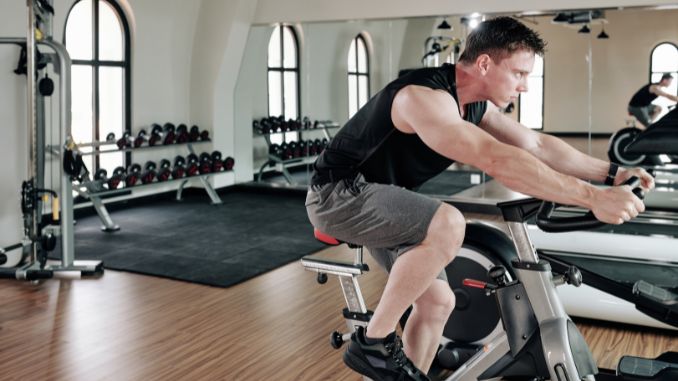Have you ever wondered which is more effective for weight loss: cardio or weights? Well, the answer may surprise you. It’s not a matter of choosing one over the other; it’s about combining cardiovascular exercise and weight training for optimum fat loss.
- Understanding cardio and weight training
- The science behind combining cardio and weights for weight loss
- Top 10 Effective Cardio and Weight Exercise Combinations
- Creating a cardio and weight training routine
- Tips for maximizing weight loss with cardio and weights
- Conclusion: The power of the dynamic duo for long-term weight loss success
Cardiovascular exercises like running, cycling, or swimming can effectively burn calories and enhance heart health. Meanwhile, weight training facilitates the development of lean muscle mass, which subsequently accelerates your metabolism, enabling you to burn more calories throughout the day. This article will give you a clear roadmap to create a balanced exercise routine that maximizes weight loss.
Understanding cardio and weight training
Cardiovascular exercise, commonly known as cardio, is any activity that increases your heart rate and your breathing. It includes exercises like running, cycling, swimming, and jumping rope. Cardio exercises aim to enhance the health and productivity of your heart and lungs. They elevate your heart rate and help you burn calories.
Weight training, popularly called resistance training or strength training, involves utilizing weight or resistance machines to exercise your muscles. This type of workout assists in developing and fortifying your muscles, increasing muscle mass. It’s a misconception that weight training is solely for bodybuilders. It offers numerous benefits for weight loss and overall health.
The benefits of cardio for weight loss
Cardio exercises effectively burn calories, leading to fat loss. They increase heart and respiratory rates, resulting in increased energy expenditure. Cardiovascular exercise can improve heart health, lower blood pressure, and reduce chronic disease risk. Additionally, they enhance endurance, stamina, and overall fitness levels. To maximize weight loss, choose enjoyable and challenging activities. Health experts suggest that adults aim for 2 1/2 hours of moderate-intensity or 75 minutes of vigorous-intensity cardio per week. These sessions can be split up into smaller intervals for convenience.
The advantages of weight training for weight loss
Weight training has unique benefits for fat loss beyond just burning calories during the workout. Incorporating weight training into your routine can effectively aid weight loss by increasing your basal metabolic rate (BMR). To achieve this, you need to build lean muscle mass, which burns extra calories even at rest because it’s more metabolically active than other tissue types, such as fat. In addition, weight training can also help reduce body fat and improve muscle definition, resulting in a toned and sculpted physique. To get started, begin with basic exercises that target major muscle groups.
The science behind combining cardio and weights for weight loss
During cardio, your body primarily uses carbohydrates for energy. But when you add weight training, it taps into stored fat because of increased energy demands.
Weight training also triggers an “afterburn” effect called excess post-exercise oxygen consumption (EPOC). After an intense session, your body keeps burning calories as it repairs muscles and replenishes energy stores, providing hours or even days of calorie burning.
This duo also safeguards against muscle loss during weight loss. When you cut calories, there’s a risk of losing muscle along with fat. But with weight training, you can maintain and grow muscle, achieving a more toned physique.
What is the best cardio-to-weight ratio for weight loss?
While there is no one-size-fits-all answer to the ideal cardio-to-weights ratio for weight loss, a general rule of thumb is that your total weekly cardio time should be, at most, half the time you spend lifting weights. For example, if you spend 90 minutes lifting weights four times a week, your total cardio time should be at most 180 minutes in that week. This ratio lets you focus on building strength and muscle while incorporating enough cardiovascular exercise to promote fat loss.
It’s important to note that the specific ratio may vary depending on individual factors such as fitness level, goals, and preferences. It’s always a good idea to consult a fitness professional or trainer who can tailor a workout plan to suit your specific needs. Additionally, listening to your body and adjusting as needed is essential. If you are not seeing the desired results or feeling excessively drained, it may be necessary to adjust the cardio-to-weights ratio accordingly.
Top 10 Effective Cardio and Weight Exercise Combinations
Cardio and weight exercise combinations strategically integrate cardiovascular workouts and strength training exercises in a fitness routine to achieve maximum weight loss and overall fitness benefits.
#1 Cardio Exercise: High-Intensity Interval Training (HIIT)
- Target Area: HIIT workouts are excellent for burning calories, including abdominal fat, and reducing overall body fat,
#2 Weight Exercise: Kettlebell Swings
- Target Area: Kettlebell swings engage the core muscles, including the abdominal muscles, helping to strengthen and tone the tummy area.
#3 Cardio Exercise: Rowing
- Target Area: Comprehensive full-body workout, emphasizing the legs, back, and arms.
#4 Weight Exercise: Deadlifts
- Target Area: Engages the entire body, particularly the lower back, legs, glutes, and upper back.
#5 Cardio Exercise: Cycling
- Target Area: Focuses on the lower body, including the quadriceps, hamstrings, and calves.
#6 Weight Exercise: Leg Press
- Target Area: Mainly targets the leg muscles, including the quadriceps, hamstrings, and glutes.
#7 Cardio Exercise: Swimming
- Target Area: Provides an overall cardiovascular workout while engaging various muscle groups, particularly the shoulders, back, and core.
#8 Weight Exercise: Lat Pulldowns
- Target Area: Primarily targets the upper back and latissimus dorsi muscles.
#9 Cardio Exercise: Elliptical Training
- Target Area: Offers a low-impact, full-body workout involving the legs, arms, and core.
#10 Weight Exercise: Shoulder Press
- Target Area: Focuses on the shoulder muscles, particularly the deltoids.
Creating a cardio and weight training routine
Consider your goals, fitness level, and time availability to create a well-rounded cardio and weight training routine. Here’s a step-by-step guide to help you design an effective routine:
- Set Your Goals: Determine your workout objectives, whether it’s weight loss, muscle building, or overall fitness. Clear goals will guide exercise selection and progress tracking.
- Assess Your Fitness Level: Be honest about your current fitness. Beginners should start with lighter weights and lower-intensity cardio, gradually increasing as strength and comfort grow.
- Choose Your Exercises: Pick cardio activities you enjoy and that challenge you, such as running, cycling, swimming, dancing, or HIIT. For weight training, focus on compound exercises targeting multiple muscle groups.
- Determine Frequency: Strive for balance with at least three to five days of cardio and two to three days of weight training each week.
- Plan Your Workouts: Create a schedule including cardio and weight training sessions. Alternate between them or combine both in one session, finding a routine that suits your lifestyle.
- Monitor Progress: Keep tabs on your workouts, noting exercises, sets, reps, and weights used. This allows you to track improvements and adjust your routine using fitness apps or a journal for convenience.
- Warm Up and Cool Down: Always warm up with stretches and cool down with static stretches to prevent injuries and enhance flexibility. Adjust workout intensity or duration when necessary.
Designing a fitness routine tailored to your goals and fitness level will help you achieve your desired results while staying safe and motivated.
Tips for maximizing weight loss with cardio and weights
To maximize the effectiveness of your cardio and weight training routine, keep these tips in mind:
- Prioritize Intensity: Opt for higher-intensity workouts to maximize weight loss. Challenge yourself with interval training, circuit training, or increasing weights/resistance to push your limits.
- Incorporate HIIT: High-intensity interval Training (HIIT) is excellent for fat-burning and cardiovascular fitness. Alternate short bursts of intense exercise with active recovery periods to boost calorie burn.
- Combine Cardio and Weights: If time is tight, merge cardio and weight training in one session. Use circuit training, alternating between cardio and weight exercises with minimal rest. It saves time and amps up the calorie burn.
- Stay Consistent: Consistency is fundamental to weight loss goals. Make exercise a regular routine, even with shorter workouts on busy days. Remember, consistency pays off.
- Fuel Your Body: Support your workouts and weight loss with nutrient-dense foods. Prioritize lean proteins, whole grains, fruits, veggies, and healthy fats. Stay hydrated, and consider consulting a dietitian for personalized nutrition guidance.
- Enough Rest: It is essential to get enough rest for proper recovery. Giving your body time to rest between workouts is necessary to prevent overtraining and reduce the risk of injury. Additionally, aim for 7 to 9 hours of quality sleep each night to promote optimal recovery and well-being.
Conclusion: The power of the dynamic duo for long-term weight loss success
Combining cardiovascular exercise and weight training is the ultimate strategy for maximizing weight loss. Cardio workouts torch calories and enhance cardiovascular health, while weight training constructs lean muscle and revs up metabolism. Integrating both exercise types into your routine creates a potent synergy that supercharges weight loss, shapes your physique, and elevates overall fitness.
Remember, every fitness journey is unique, and progress unfolds gradually. Stay committed to your goals, commemorate your milestones, and embrace the dynamic duo of cardio and weights. With dedication and perseverance, you’ll embark on a path to enduring weight loss success and a healthier, happier you.














